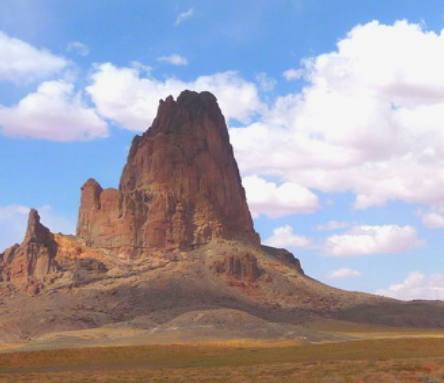Volcanic Plug
A volcanic plug or neck is formed when magma from an existing volcano
solidifies in the pipe or neck and the surrounding sediment is eroded
away.
Morro
Rock in California is a volcanic plug
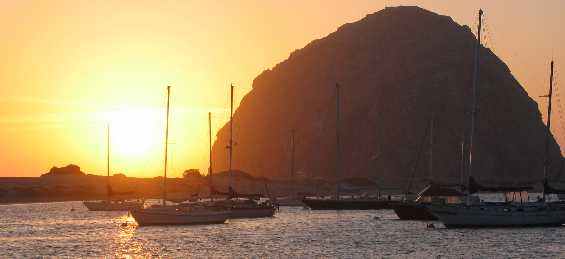
Morro
Rock is one of a line of ancient volcanic intrusions or plugs
sometimes called the Seven Sisters or The Nine Morros, depending on
how many of the peaks are included in the count. They are a unique
set of landmarks between the city of Morro
Bay and the City of San Luis Obispo in California.
Morro
Rock and indeed all of the Seven Sisters or The Nine Morros,
are all volcanic necks, the rock that solidified in the "piping"
of the volcano after it quieted down. The volcanic cones have long
since eroded away.
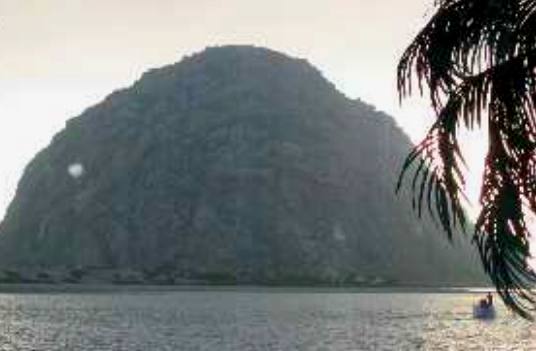
My Roadside Geology of California Book indicates that Morrow
Rock is the rhyolite plug from a volcano active some 24-million
years ago.
Rhyolite is the granite like mass of once molten magma that cooled
in the "vent pipe" of the volcano before reaching the surface.
It is much harder than either volcanic ash or surrounding sedimentary
rocks. Thus the other materials have eroded away leaving this 576'
high monument as a sentinel marking the entrance to Morro
Bay.
Cabezon Peak is a Volcanic Plug in
northern New Mexico
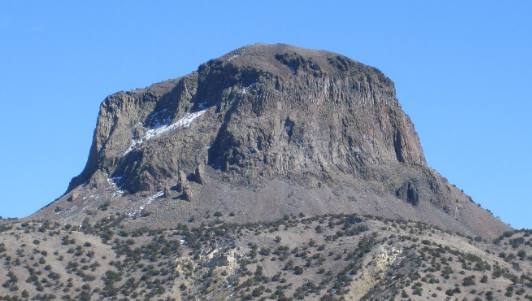
Cabezon Peak is a large volcanic plug that can be seen in northern
New Mexico.
The top of Cabezon Peak or volcanic plug is at an elevation of 7,785
feet.
If you are looking for Cabezon Peak it is around two miles south
of the old ghost town of Cabezon and the Rio Puerco, River. Or around
50-miles northwest of Albuquerque.
This volcanic neck is formed of basalt.
In case you are interested Cabezon means “big head” in
Spanish.
While in New Mexico let's visit another prominent volcanic plug Ship
Rock.
Ship Rock Volcanic Plug in northwestern New Mexico
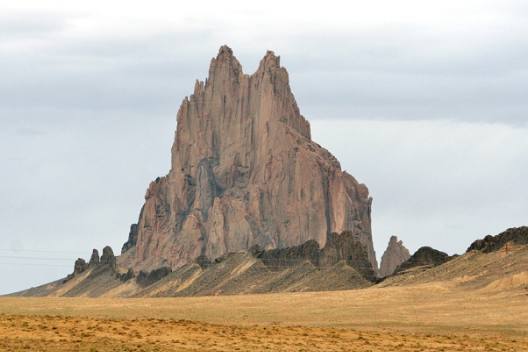
The exposed neck of the Ship Rock plug is thought to have been formed
around 3,000 feet below the earth's surface.
It is only exposed now after millions of years of erosion.
What you see here is the fossil remains or innards of a volcano that
congealed while underground around 25-million years ago.
What is left is the once molten rock that cooled while in the neck
of the active volcano before reaching the surface.
El Captain is a volcanic plug that can be seen in Monument Valley,
Arizona.
El Captain is located in Arizona a few miles north of the Navaho
town of Kayenta, Arizona. Look for El Captain when you are visiting
Monument Valley. It is also off of US-163 the highway between Kayenta,
Arizona and Mexican
Hat, Utah.
Look for it when you are in the area. It is an impressive piece of
geology.
Devils
Tower in northeastern Wyoming is the classic
volcanic plug
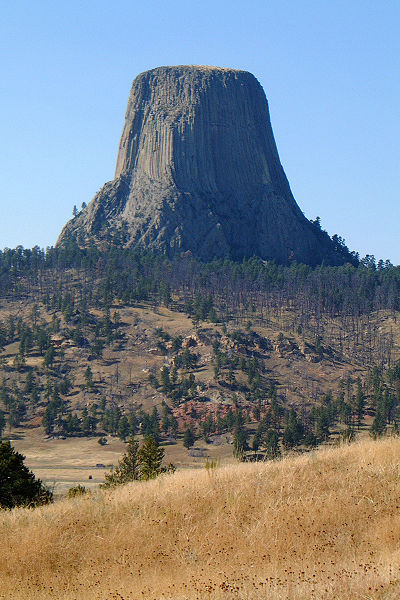
While I say that Devils
Tower is a volcanic plug some geologists believe the molten
rock comprising the plug might not have reached the surface before
it cooled. Thus it would just be a dike.
Other geologist are convinced the tower is all that remains of what
once was a large explosive volcano.
While it is true that some knowledgeable experts maintain that Devils
Tower is an eroded remnant of a laccolith. A laccolith being
a large mass of igneous rock which is intruded through sedimentary
rock but does not actually reach the surface. Laccoliths usually produce
rounded bulges in the sedimentary layers above. As you can see devils
tower is not rounded like traditional laccoliths (two come to mind
Enchanted
Rock in the Hill Country of Texas and Morro
Rock in California).
Personally, but I am not a geologist think Devils
Tower is a volcanic plug --specifically it is the congealed
neck of an extinct volcano. If Devils Tower was a volcanic plug, any
volcanics created by it — volcanic ash, lava flows, volcanic
debris are all long gone having been eroded away long ago.
Keep in mind that Devils
Tower did not visibly protrude out of the landscape until
the overlying sedimentary rocks eroded away over millions of years.
As the surrounding sedimentary layers eroded away, the more resistant
igneous rock in the neck ( the tower) survived. This is what is visible
after millions of years of erosion has washed away the softer surrounding
materials.
Piles of broken columns, boulders, small rocks, and stones —
or scree — lie at the base of the tower, indicating that it was
once wider than it is today. So the elements are working on the exposed
hard igneous rock in the neck as well as the surrounding layers of
sedimentary material.
Think about what Devils
Tower will look like in another million years. It will be
smaller in diameter as erosion does its thing. But more of the "plug"
may be exposed. Will the "plug" get larger as more sedimentary
rock is eroded away?
Here are some other noted "volcanic plugs".
Church volcanic plug in Le Puy, France
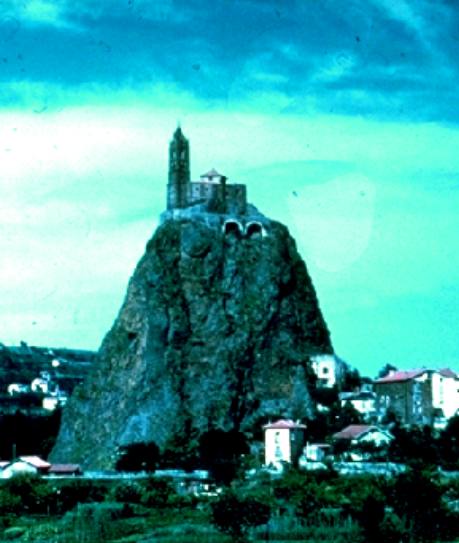
The volcanic landscape in southern France produced a volcanic plug
in the city of Le Puy. Because of its distinct shape and prominent
location, the rock “needle” (aiguilhe in French) has been
a special and sacred place since it was first spotted by humans.
Saint Michel d’Aiguilhe in Le Puy en Velay in southern France
seems to grow out of the volcoanic plug it was built on. It is a steep
climb up 268 steps to the top, or 280 ft up if you prefer that measure.
Saint-Michel d’Aiguilhe Chapel (Le Puy-en-Velay,
France)

This is a volcanic plug a chapel perched on it.
This is the Rock of Aiguilhe (Aiguilhe is French for needle), in
the town of Puy en Velay, in the Auvergne in southern France. The
Chapelle Saint-Michel has stood there for 1042 years, since it was
built in 962.
Weavers Needle is a towering lava
plug in the Superstition Mountains of Arizona
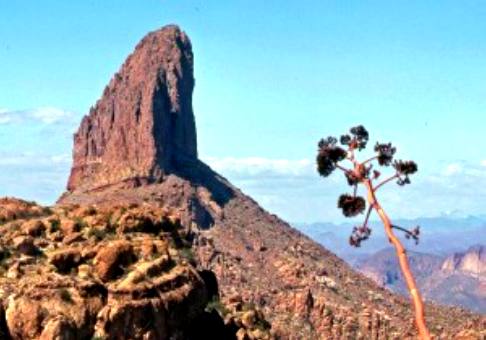
Weavers Needle lava plug in the Superstition Mountains
of Arizona
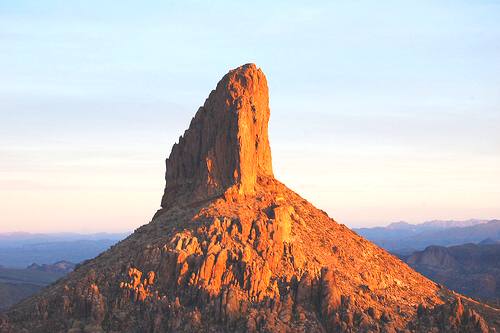
Some knowledgeable people maintain that Weavers Needle is not a volcanic
plug. They maintain that it was formed as an erosional remnant.
With an erosional remnant being what is left of the original after
erosion.
Others still maintain that Weavers Needle is indeed a lava plug.
It looks like a lava plug or dike to me. But I am certainly not an
expert. VBG
Mike & Joyce Hendrix

Mike
& Joyce Hendrix who we are
We hope you liked this page. If you do you might be interested in
some of our other Travel Adventures:
Mike & Joyce Hendrix's home
page
Travel Adventures
by Year ** Travel
Adventures by State ** Plants
** Marine-Boats
** Geology ** Exciting
Drives ** Cute Signs
** RV
Subjects ** Miscellaneous
Subjects
We would love to hear from you......just put "info" in
the place of "FAKE" in this address: FAKE@travellogs.us
Until next time remember how good life is.



